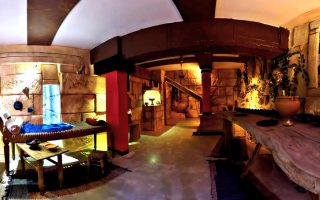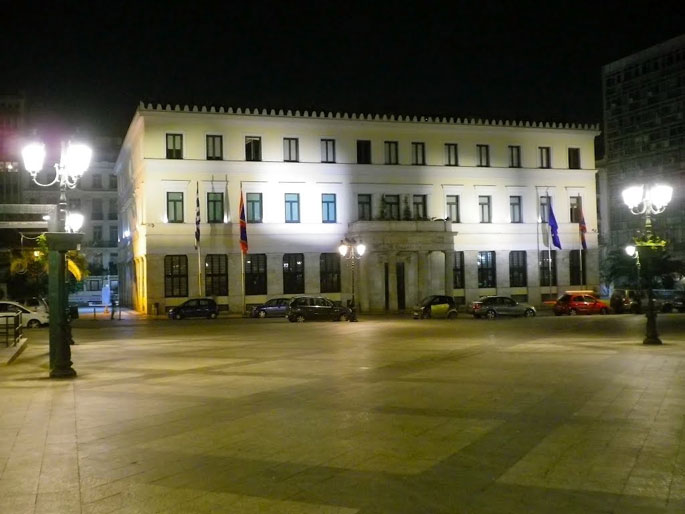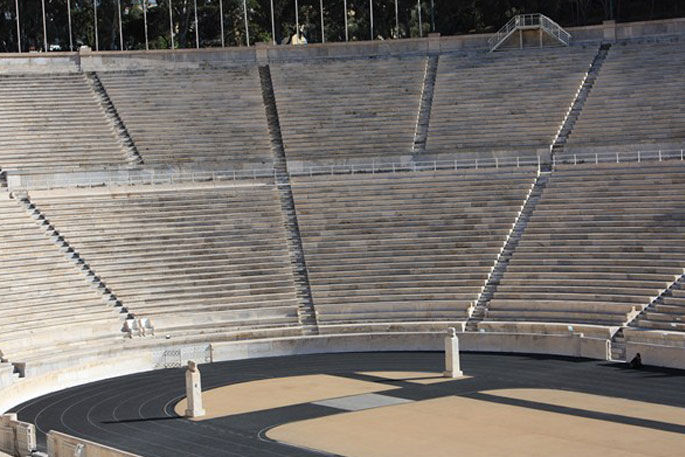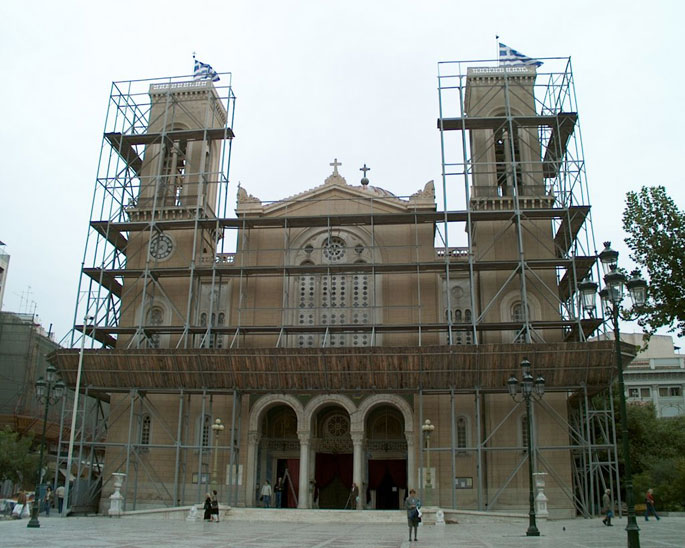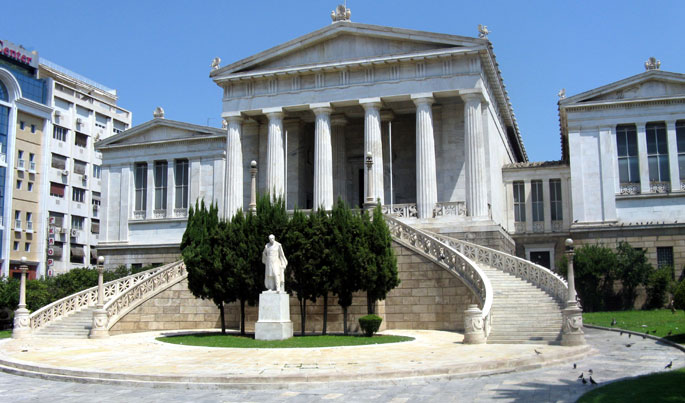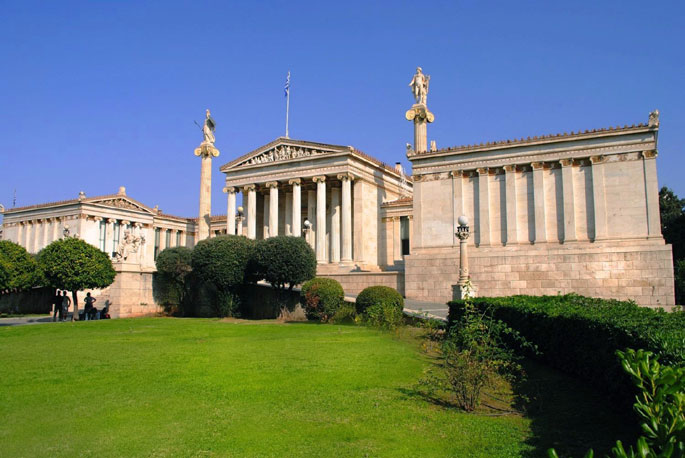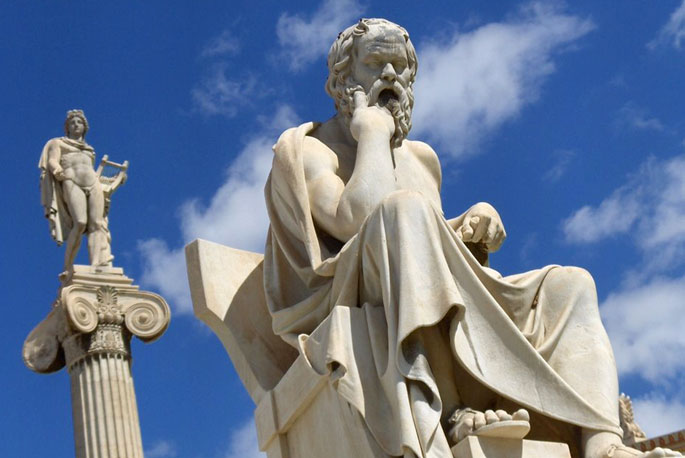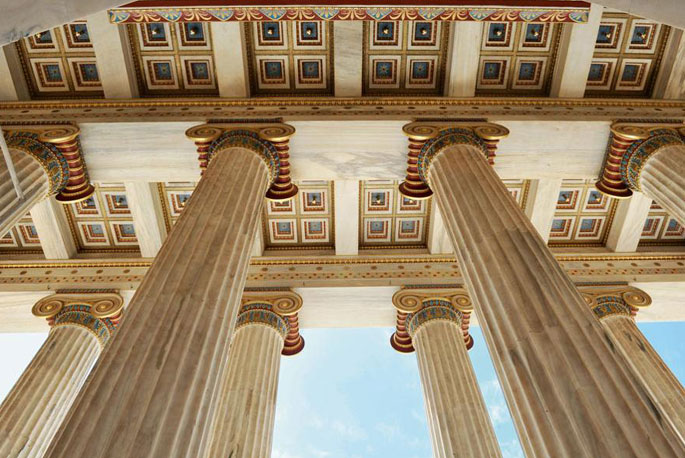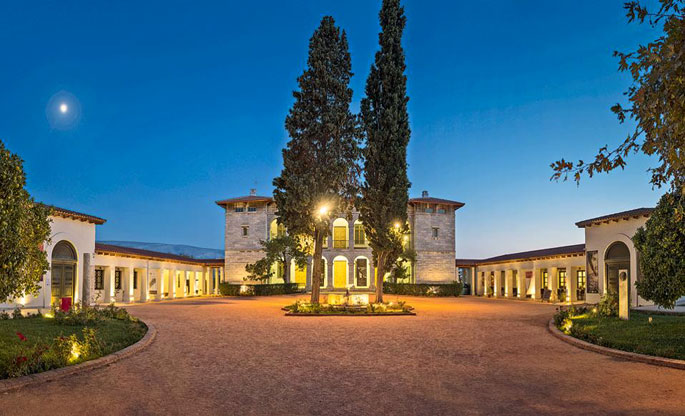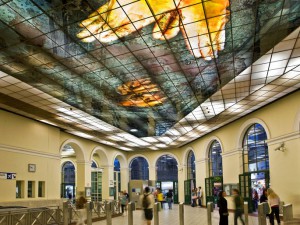 Built between 1890-1895, the Monastiraki subway station became the first steam-train railway connecting Athens and Piraeus. Having operated locally since 1869, its main terminal was located in Thission, its extension to Monastiraki, built by businessman, Stephanos Psihas. During construction, extensive archaeological excavations were conducted, revealing a plethora of interesting relics, many which are still present today.
Built between 1890-1895, the Monastiraki subway station became the first steam-train railway connecting Athens and Piraeus. Having operated locally since 1869, its main terminal was located in Thission, its extension to Monastiraki, built by businessman, Stephanos Psihas. During construction, extensive archaeological excavations were conducted, revealing a plethora of interesting relics, many which are still present today.
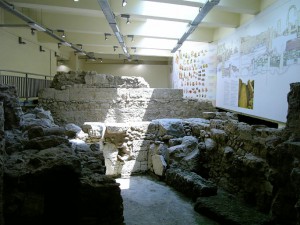 Passengers travelling from Thission to the new station will see many ancient relics and remnants of the city’s historic past. In 1904, the steam trains were converted to electricity, and from 1926 to 1930 the line was further extended, tunnelling from Monastiraki to the Omonia station. In 2000 this station, along with all of the other older stations, was fully refurbished, an architectural gem, displaying myriad antiquities.
Passengers travelling from Thission to the new station will see many ancient relics and remnants of the city’s historic past. In 1904, the steam trains were converted to electricity, and from 1926 to 1930 the line was further extended, tunnelling from Monastiraki to the Omonia station. In 2000 this station, along with all of the other older stations, was fully refurbished, an architectural gem, displaying myriad antiquities.
Source: www.athensattica.gr
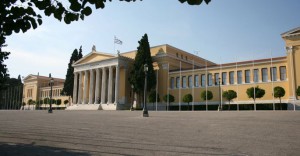 Located next to the National Gardens, the Zappeion Mansion, or simply, “Zappeion,” as it is called by the locals, is one of the most impressive and important historical buildings in Athens. As early as 1859, the Greek Government had been contemplating renovation of the structure, using plans drawn up by Greek architect, Theophilas and his French counterpart, Boulanger. And though well-funded by Greek benefactor, Evangelos Zappas, the project never quite got off the ground.
Located next to the National Gardens, the Zappeion Mansion, or simply, “Zappeion,” as it is called by the locals, is one of the most impressive and important historical buildings in Athens. As early as 1859, the Greek Government had been contemplating renovation of the structure, using plans drawn up by Greek architect, Theophilas and his French counterpart, Boulanger. And though well-funded by Greek benefactor, Evangelos Zappas, the project never quite got off the ground.
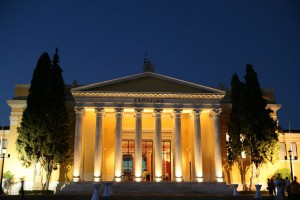 Eventually, however, Danish architect Hanssen became involved and the project was finally given the green light. The official inauguration took place in 1888 and since then, this building has become one of the primary symbols of modern Athens. During its tenure, the building has been home to an eclectic variety of functions; exhibitions, official ceremonies, the first modern Olympic Games of 1896, and in 1936, the Hellenic Radio Station. Today it serves as a press center for political parties during elections.
Eventually, however, Danish architect Hanssen became involved and the project was finally given the green light. The official inauguration took place in 1888 and since then, this building has become one of the primary symbols of modern Athens. During its tenure, the building has been home to an eclectic variety of functions; exhibitions, official ceremonies, the first modern Olympic Games of 1896, and in 1936, the Hellenic Radio Station. Today it serves as a press center for political parties during elections.
Source: www.athensattica.gr
Designed by architect Panagiotis Kalkos, the old City Hall on Athenas Street was built between 1871 and 1874, during the mayoral reign of P. Kyrakos. Initially constructed as a two-story building with a tile roof and Doric order entrance, it was aesthetically and architecturally related to the adjacent Varvakeios School, a Neo-Classical building, also designed by Kalkos, which was destroyed in 1944.
In the 20th Century, City Hall underwent multiple renovations under mayors Spyros Merkouris in 1901, and Amvrossios Plytas between 1935 and 1937. A third floor was added to the building and extensive work was done on its exterior decoration. In the late 20th Century, the building was declared a listed building, and some of its exterior decorative elements were restored to their 19th century style.
Source: www.athensattica.gr
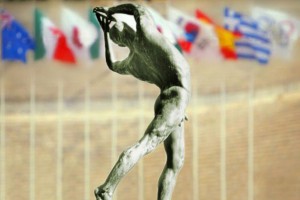 The impressive Panathenaic Stadium is also known as the Kallimarmaro (“the one made with beautiful marble”). Founded in the 4th century under the rule of Lycourgos, on the slopes of Ardittos hill, it was restored and expanded by Hadrian Atticus. Following the city’s decline during the Christian era, and the Franc and Ottoman occupations, the stadium gradually fell into disrepair, eventually being buried under tons of dirt.
The impressive Panathenaic Stadium is also known as the Kallimarmaro (“the one made with beautiful marble”). Founded in the 4th century under the rule of Lycourgos, on the slopes of Ardittos hill, it was restored and expanded by Hadrian Atticus. Following the city’s decline during the Christian era, and the Franc and Ottoman occupations, the stadium gradually fell into disrepair, eventually being buried under tons of dirt.
 But the site was excavated and the ancient stadium was fully restored in time to host the first Modern Olympic Games in 1896. Since that time, the stadium has been connected to all major sports events in Greece. As a tribute to the original Marathon run, the Marathon International road race, held annually to commemorate Spyros Louis’ marathon victory at the first modern Olympic Games, ends here. The stadium was also the finishing point of the Athens, 2004 Olympic Games Marathon.
But the site was excavated and the ancient stadium was fully restored in time to host the first Modern Olympic Games in 1896. Since that time, the stadium has been connected to all major sports events in Greece. As a tribute to the original Marathon run, the Marathon International road race, held annually to commemorate Spyros Louis’ marathon victory at the first modern Olympic Games, ends here. The stadium was also the finishing point of the Athens, 2004 Olympic Games Marathon.
Stadium site: www.panathenaicstadium.gr
Source: www.athensattica.gr
Dedicated to the Annunciation of the Mother of God, The Athens Metropolitan Cathedral was built between 1842 and 1862, its three-aisled, domed basilica overlooking a street with the same name. Located a short distance from Syntagma square, its design and construction was enhanced by the many famous architects who contributed their time and talents; Hanssen, Zezos, Boulanger, Kalkos and others. Additionally, numerous fine artists worked on both the exterior and interior decoration of the temple. Architectural materials and decorative pieces from derelict, byzantine churches and churches razed for archaeological reasons were also used in the Cathedral’s construction.
Since its inauguration, the Athens Cathedral has remained the site of many significant ceremonies, from the weddings of Kings, to funerals of important political and social figures. Following the massive earthquake that shook Athens in 1999, the Cathedral has been undergoing continuous maintenance and restoration. Services are therefore being temporarily held in the Church of St. Dionysius, in Kolonaki. The Cathedral houses the marble shrines containing the holy remnants of Agia Filothei and the Patriarch Gregorius V.
Source: www.athensattica.gr
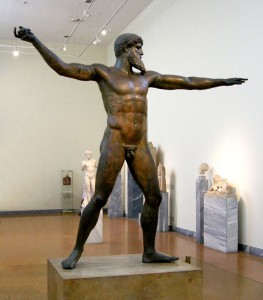 Situated in the very heart of the city, the National Archaeological Museum on Patission Street, houses some of the most important artefacts of the ancient world, from the neo-lithic era until the late Roman period; the treasure from the Antikythera wreck, Agamemnon’s death mask, the wall paintings of Thera, the Artemision Bronze, the Antikythera Ephebe, Nestor’s Cup, and the Marathon Boy are but a few of the important findings to be admired in the museum. Located in the facility’s southern annex is the Epigraphical Museum, safeguarding the world’s largest collection of ancient Greek inscriptions.
Situated in the very heart of the city, the National Archaeological Museum on Patission Street, houses some of the most important artefacts of the ancient world, from the neo-lithic era until the late Roman period; the treasure from the Antikythera wreck, Agamemnon’s death mask, the wall paintings of Thera, the Artemision Bronze, the Antikythera Ephebe, Nestor’s Cup, and the Marathon Boy are but a few of the important findings to be admired in the museum. Located in the facility’s southern annex is the Epigraphical Museum, safeguarding the world’s largest collection of ancient Greek inscriptions.
Covering an entire city block, and adjacent to Metsovion National Technical University, this massive museum complex was designed and built according to the Neo-classic, architectural style prevailing in Greece and Europe during the 19th Century. A walk around the artefacts and collections exhibited in the museum is, quite simply, an awe-inspiring experience. To wind down, take a stroll around the large, neo-classic garden located in the front and at the side of the museum.
Museum web site: www.namuseum.gr
Source: www.athensattica.gr
After many intrigues and adventures, the Athens Catholic Church was finally erected, at the junction of Panepistimiou and Omirou streets. Although the lot had been purchased in 1847, and all necessary studies completed by the distinguished German architect Klenzef, construction on the majestic, three-clite basilica didn’t begin until 1853 and was frequently interrupted due to the lack of funds. Then, in 1858 Lyssandros Kaftantzoglou undertook to resume the work, suggesting that a smaller, simpler version of the church be built, based on the original plans.
 After eliminating the need for a belfry, and employing a more minimalistic approach, one more in tune with existing architectural forms of Athenian Neo-classicism, the church was soon finished. However, its gates didn’t opened until 1865, three years after the ousting of King Otto. Additional work went on until 1875, when the Holy Altar, the entrance, the porch, the nearby archbishop’s residence, and other secondary buildings had been added to the complex. The vitreaux decorations were built in Munich, in the late 19th Century, and even more improvements were subsequently added. After 1960, an extensive restoration was performed in order to return the church its original form.
After eliminating the need for a belfry, and employing a more minimalistic approach, one more in tune with existing architectural forms of Athenian Neo-classicism, the church was soon finished. However, its gates didn’t opened until 1865, three years after the ousting of King Otto. Additional work went on until 1875, when the Holy Altar, the entrance, the porch, the nearby archbishop’s residence, and other secondary buildings had been added to the complex. The vitreaux decorations were built in Munich, in the late 19th Century, and even more improvements were subsequently added. After 1960, an extensive restoration was performed in order to return the church its original form.
Source: www.athensattica.gr
The imposing building of the National Library is the easternmost of the three-building complex known as the Athenian Trilogy. Built in the 19th century to house the National Library, the University of Athens, and the Academy, the Library was designed by the famous architect, Theophil von Hansen, and financed by the Vallianos family, Greek businessmen of the diaspora. Constructed with white Pentelic marble, and enhanced by Doric columns, the building also boasts a stunning, renaissance-style, twin staircase.
The facade and vestibule are decorated with statues of the Vallianos family. It is worth noting that the National Library of Greece was originally established by Governor Ioannis Kapodistrias on the island of Aegina in 1829. At the time, the library’s vast collections were housed in numerous buildings, one of which was the small chapel of Agios Elefterios next the Cathedral. Subsequently, even more library materials were housed in the University of Athens, the two collections finally being merged in 1866, and moved permanently to its current location in 1902.
Source: www.athensattica.gr
This imposing, archaic building was built from 1859 until 1885, and was sponsored by the family of business entrepreneur, Baron Simon Sinas, who then lived in Vienna. Based on plans by Danish architect, Theophile Hanssen, and supervised by Ernst Ziller, the precise location of the construction site had already been selected in 1842, specifically chosen to be part of the famous “Athenian trilogy” of neo-classical buildings.
 Based on Ionian era designs, the building is covered in white Pentelic marble, and its pediments adorned with Peiraic stone; statues of Athena, goddess of Letters, and Apollo, god of the Arts, both created by Leonidas Drossis, are seen standing on two high Ionic order columns overlooking the entrance. Two other impressive statues greet visitors at the entrance escalade, Plato and Aristotle. Though originally drawn by Drossis, these two statues were not completed until after his death. And although the building was ready for occupancy in 1885, the Academy was not officially founded until 1926, when it commenced operations as the supreme research establishment in the country.
Based on Ionian era designs, the building is covered in white Pentelic marble, and its pediments adorned with Peiraic stone; statues of Athena, goddess of Letters, and Apollo, god of the Arts, both created by Leonidas Drossis, are seen standing on two high Ionic order columns overlooking the entrance. Two other impressive statues greet visitors at the entrance escalade, Plato and Aristotle. Though originally drawn by Drossis, these two statues were not completed until after his death. And although the building was ready for occupancy in 1885, the Academy was not officially founded until 1926, when it commenced operations as the supreme research establishment in the country.
Source: www.athensattica.gr
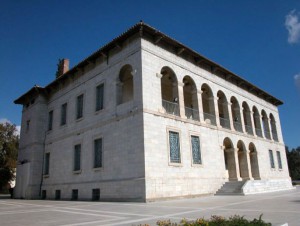 The Byzantine and Christian Museum on Vasilissis Sofias street is one of the most important Byzantine and post-Byzantine era museums in the world, with more than 25.000 objects dating from the 2nd century A.C. to the present. Containing exhibits acquired not only from Greece, but from Asia Minor and the Balkans as well, the museum, housed in the Villa Ilissia, is a magnificent example of 19th century architecture, dating from the earliest years of Greece’s liberation.
The Byzantine and Christian Museum on Vasilissis Sofias street is one of the most important Byzantine and post-Byzantine era museums in the world, with more than 25.000 objects dating from the 2nd century A.C. to the present. Containing exhibits acquired not only from Greece, but from Asia Minor and the Balkans as well, the museum, housed in the Villa Ilissia, is a magnificent example of 19th century architecture, dating from the earliest years of Greece’s liberation.
Designed by renowned Greek architect, Stamatios Kleanthis, the complex was originally built for the Duchess of Placentia, who had lived in Athens for many years. The main structure, a two-story building with a basement, was the Duchess’ primary residence. After her death, ownership of the property was transferred to the state, along with the other buildings in the complex. In 1926 the complex was assigned to house the Byzantine and Christian Museum and, after necessary alterations, opened its doors.
Museum web site:www.byzantinemuseum.gr
Source: www.athensattica.gr







